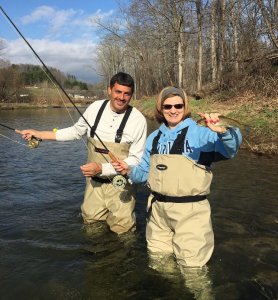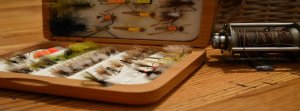Asheville is Fly Fishing Country!

trout fishing asheville
Do you seek out a fly fishing adventure year round? Asheville, North Carolina provides anglers with fishable streams 12 months out of the year, and all you need are a couple of dry flies and nymph patterns to make that happen!
From the Southern Appalachian Mountain Range to the Blue Ridge Mountains there are thousands of streams worth fishing if you can find them. Most of these rivers and streams you can catch all three types of trout including brook trout, rainbow trout and brown trout. Wild fish can be found throughout our WNC region as well as stocked trout. There are over 3,000 miles of trout streams in Western North Carolina open to fly fishing and choosing can become difficult. Many of these streams can offer beginners a place to learn, while other rivers offer experts tight places to cast into.
Type of Insects Found in Our Streams
In Asheville and Southern Appalachia, trout streams include various mayfly, stone, caddis hatches from January through December. One of the more consistent hatches include blue-winged olives, hendricksons, sulphurs, red quills and morning duns. All of these bugs can be seen hatching in Western North Carolina when the warming trends begin to pick up. Anglers will see hatches from early March to late November.
Another year round fly that proves productive in Southern Appalachia is the elk-hair caddis and the yellow stone. When the water begins to warm up trout will begin to feed on dry flies more commonly, so pull out an elk-hair caddis on slower drifts.
 Fly Patterns
Fly Patterns
When the water temperature is at least 40 degrees, trout will become more active. Around Western North Carolina, April through May are when the most insect hatches come off and trout begin to feed heavily on a variety of insects. Primary hatches for this time of the year include:
- No. 14 Red Quill
- No. 18 Blue Quill
- No. 14 Light Cahill
- No. 12 Yellow Mayfly
- No. 16-12 Elk Hair Caddis
- No. 10 Yellowhammer
- No. 10 Tellico
- No. 14 Green Drake
Using larger flies during the month of May can offer some big strikes from larger fish. Sometimes the bigger the fly the better. There are many flies in May that get into the No. 8 size range. Try casting larger flies in the afternoon through dusk for a big bite!
Smaller Rivers vs. Larger Rivers
There is a big difference between the types of bugs in small and larger rivers. It is proven by scientists who’ve done trout stomach content analysis, that 85% of a trouts diet in smaller rivers contains terrestrials. Larger rivers offer larger hatches and more river insects for trout to rely on. In these larger rivers trout position themselves for the river to bring them food with current breaks and slow drifts. Smaller creeks are loaded with ants, crickets, worms, inch worms, beetles, spiders and more. Trout in these smaller rivers are forced to live in confined holes or pockets where predators like hawks, eagles and fisherman alike won’t see them. Smaller rivers are also full of moths, bees, wasps, and other types of flies where trout can depend on. If trout had to rely on mayflies and caddisflies in a smaller creek then they would starve.
In smaller rivers there are many scuds and smaller insects that are not that apparent when stepping foot into the stream. Pick up a couple rocks and inspect the river before tying on a fly. Who knows, you might even find some large stoneflies or caddis.
